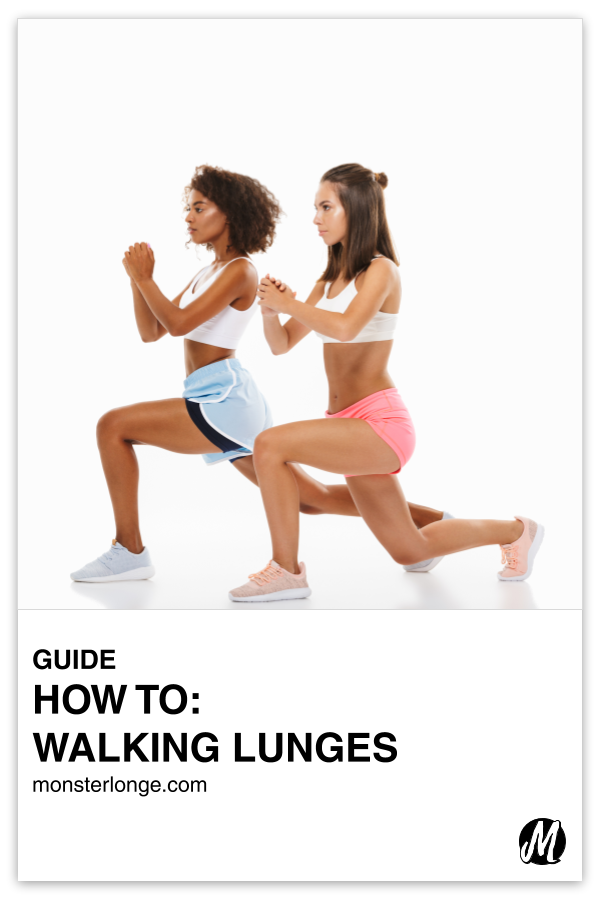
How To: Walking Lunges
Unilateral exercises involve using the muscles on one side of the body at a time rather than together in performance of a movement. Doing so is great for isolating muscles and avoiding imbalances between muscle groups, which goes a long way toward appearing symmetrical…in addition to injury prevention, if you care about that sort of thing! As an added bonus, there’s also something known as the “crossover effect”, in which unilateral training strengthens the unused side as well as the one that’s being trained. It’s for these reasons that unilateral exercises should be a part of your training regimen.
One example of a unilateral exercise are lunges, single leg movements that primarily challenge stability and balance.
As you know, there are a variety of lunges. So what differentiates walking lunges from the others?
It’s a shot in the dark, but the walking part is probably what sets walking lunges apart from something like…ummmm…stationary lunges, which are…ummmm…performed…stationary.1Psst…”stationary” is another word for remaining still, as in “not moving”. And by walking, not only are virtually all of the muscles in the lower body activated as they are in a stationary lunge but the muscles comprising the core are brought more into play to keep the body stable and balanced as it takes each step through space.
INSTRUCTIONS
1). Stand with your feet together.
2). With your shoulders back, abs braced, and head in neutral (i.e. neither looking up nor down), take a step forward with your right leg, for example.2NOTE: Make sure to shift your weight onto the leg that’s stepping forward so your heel hits the floor first — not the toes or ball of your foot!
3). Plant your right foot into the ground and lower your body toward the floor until the thigh of your forward leg is parallel to the floor and the left knee is 1 to 3 inches above the floor.3NOTE: Keeping our attention on the back leg, imagine there’s a wall behind you. The heel of your left leg should be up and parallel to that wall, with all of the pressure of the back leg on the ball and toe of that foot.
4). Concentrate on pushing through the heel of the right leg to drive your body back up to a full standing position as you swing through and take a step forward with the left leg like you were walking, which is probably why this exercise is so cleverly called a walking lunge. Whodathunkit?!
5). Repeat.
NOTE (1): A longer stride recruits more of the glutes and hamstrings, whereas a shorter stride targets more of the quads. Take whatever stride you desire that’s in accordance with your goals. Just bear in mind that too long a stride can turn lunges into a hip flexor exercise and cause lower back discomfort, while too short a stride can lead to the knees tracking well over the toes and increase the potential for knee issues. Use your discretion. Also, another thing that depends on your training goal is the angle of your torso. The more upright the torso the more recruitment of the quads, while leaning more forward increases activation of the posterior chain. If you want to hit both areas simultaneously, lunge with your torso bent forward 45 degrees.
NOTE (2): When you take a step, the big toe side of your forward foot should line up with the big toe side of the back foot, meaning there’s little, if any, daylight between your legs. If you don’t understand, then just picture yourself walking on a tightrope. Oooooh, now you get it! So rather than lunging all over the place, you’ll be lunging in a direct straight line.
NOTE (3): If extra resistance is necessary, perform with a barbell across the shoulders or a dumbbell or kettlebell in your hand(s) held down to your side(s) or in a goblet hold.
For a workout routine that possibly includes walking lunges, as well as other exercises geared specifically to your goals, training experience, injury history, and available equipment, then find out more HERE
Glossary: abs, barbell, dumbbell, exercise, exercise equipment, glutes, goal, muscle, routine
- How To Eat Healthy During Thanksgiving - November 20, 2024
- Weight Loss Tip: no.2620 - November 20, 2024
- Is Going To The Gym Once A Week Enough? - November 19, 2024
